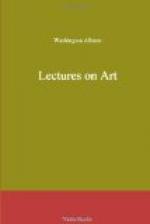The same law applies equally, and with the same limitation, to the essential differences in the intellectual, the moral, and the spiritual. All ideas, however, have but a potential existence until they are called into the consciousness by some real object; the required condition of the object being a predetermined correspondence, or correlation. Every such object we term an assimilant.
With respect to those ideas which relate to the physical world, we remark, that, though the assimilants required are supplied by the senses, the senses have in themselves no productive, cooeperating energy, being but the passive instruments, or medium, through which they are conveyed. That the senses, in this relation, are merely passive, admits of no question, from the obvious difference between the idea and the objects. The senses can do no more than transmit the external in its actual forms, leaving the images in the mind exactly as they found them; whereas the intuitive power rejects, or assimilates, indefinitely, until they are resolved into the proper perfect form. Now the power which prescribes that form must, of necessity, be antecedent to the presentation of the objects which it thus assimilates, as it could not else give consistence and unity to what was before separate or fragmentary. And every one who has ever realized an idea of the class in which alone we compare the assimilants with the ideal form, be he poet, painter, or philosopher, well knows the wide difference between the materials and their result. When an idea is thus realized and made objective, it affirms its own truth, nor can any process of the understanding shake its foundation; nay, it is to the mind an essential, imperative truth, then emerging, as it were, from the dark potential into the light of reality.
If this be so, the inference is plain, that the relation between the actual and the ideal is one of necessity, and therefore, also, is the predetermined correspondence between the prescribed form of an idea and its assimilant; for how otherwise could the former become recipient of that which was repugnant or indifferent, when the presence of the latter constitutes the very condition by which it is manifested, or can be known to exist? By actual, here, we do not mean the exclusively physical, but whatever, in the strictest sense, can be called an object, as forming the opposite to a mere subject of the mind.
It would appear, then, that what we call ourself must have a dual reality, that is, in the mind and in the senses, since neither alone could possibly explain the phenomena of the other; consequently, in the existence of either we have clearly implied the reality of both. And hence must follow the still more important truth, that, in the conscious presence of any spiritual idea, we have the surest proof of a spiritual object; nor is this the less certain, though we perceive not the assimilant.




